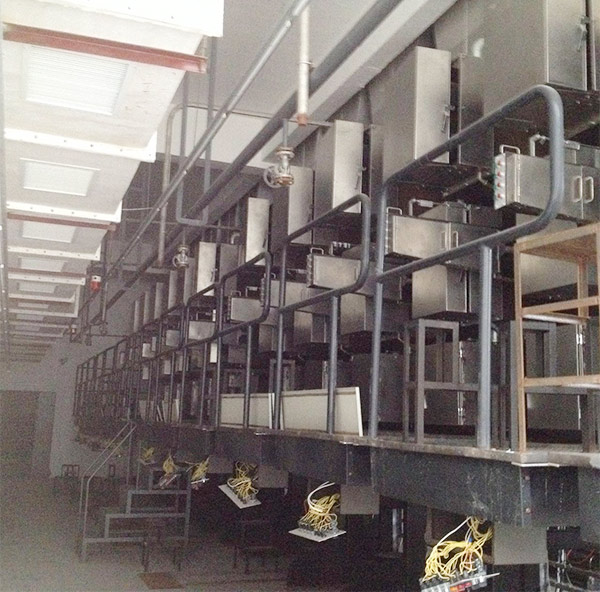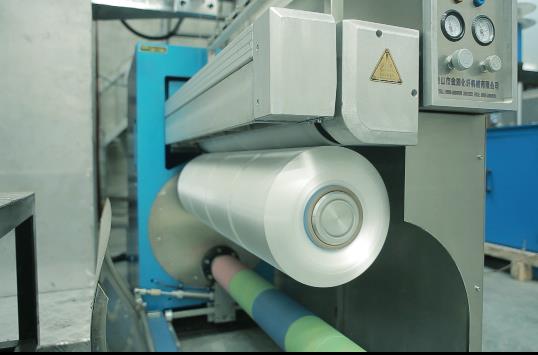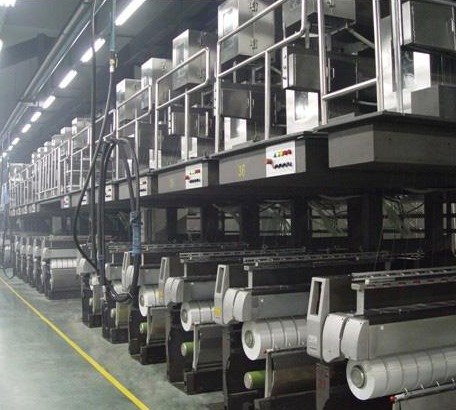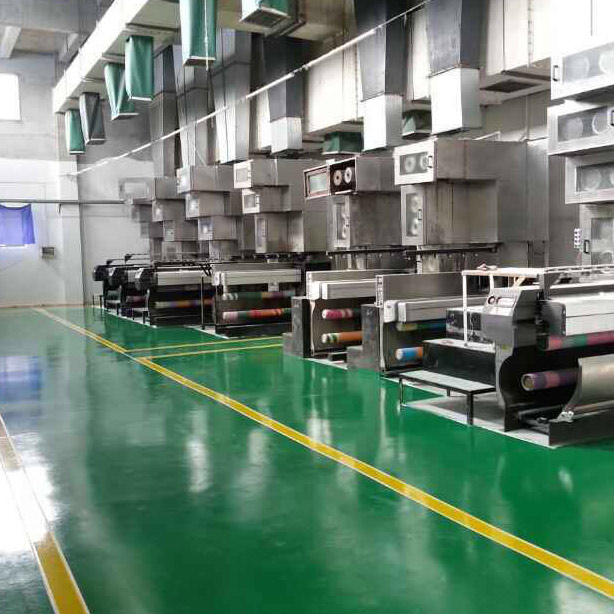- Polypropylene spinning machine
- Polypropylene FDY equipment
- Polyester POY spinning machine
- Polyamide FDY common and high strength equipment
- Polyester FDY equipment
- Polyester high strength equipment
- polyester、Polyamide、 Polypropylene BCF equipment
- Small spinning machine
- All kinds of spinning special parts
- Polypropylene FDY spinning machine is a key equipment for the production of high-performance fibers
- Several silk textile industry renewal projects in Shengze have started construction
- The Winter Solstice marks the rise of Yang energy. In Fubon spinning machines, the Winter Solstice code is revealed, a dialogue of craftsmanship spanning a thousand years
- The establishment conference of Guangzhou Modern Textile and Garment New Quality Productivity Research Institute and the co-construction conference of the textile industry innovation ecosystem were held
- The key points of control in the polypropylene FDY spinning machine process and their relationship with quality

- Contact:Mr. Huang Guofu
- Cel:0086-13901505556
- Fax:0086-519-83341119
- Email:czfb5556@126.com
- Add:No. 288-8 ChangLi Rd, Huangli Town, Changzhou, JS PRV.
Inflationary pressure and weak demand, what signal does it send
Maersk, the shipping group, recently reported better-than-expected first-quarter earnings. Maersk said the number of containers it shipped in the January-March period was 9 per cent lower than a year earlier, while rates were down 37 per cent on average.
The company reported record profits last year as surging customer demand and epidemi-related port blockages pushed up freight rates. But since then, freight rates have plummeted in the wake of the global recession and the collapse of an import bubble in the United States and other top consumers triggered by the pandemic.
Demand is weak under inflationary pressures abroad
Data showed that China's foreign trade maintained growth in the first four months of this year, with total exports reaching 7.76 trillion yuan, up 10.6 percent. Exports were particularly strong in March, rising 23.4 per cent from a year earlier, well above market expectations.
But the stronger-than-expected export growth has been matched by still-low shipping prices and a glut of empty containers sitting on terminals. Many foreign traders and freight forwarders also said they did not feel the warmth of the export growth.
While export figures have soared, it is also true that many of the containers that were once "hard to get" are now empty. Against the backdrop of weak global economic recovery and huge inflationary pressures in Europe and the US, demand from overseas consumer markets remains weak. The Euro-American market is precisely one of the important markets of our traditional manufacturing export, which aggravates the large number of container vacancies.
In March, the General Administration of Customs also responded to the problem of empty containers piling up at the port, saying that this was due to the large volume of new containers put into the port in the previous period, the low cost of domestic storage, the short-term return of empty containers in large quantities after the epidemic situation eased abroad, and the seasonal rule.
"For now, the impact of high inflationary pressures on consumption is immediate. Last year we thought exports were weak because the inventory overhang of the past few years had not been worked down, and now it looks like the foreign consumer has no money in his pocket." An official of a company said that at the beginning of the outbreak of COVID-19, the efficiency of major shipping routes fell sharply due to factors such as supply chain disruptions. However, the situation began to reverse in the second half of 2021. As crude oil prices fell, the pressure of the global supply chain gradually eased and demand began to decline, the container market changed from "one container hard to get" to "empty container pile up". Superimposed last year's high base, CCFI freight index year-on-year once appeared about 70% decline.
Empty containers are not enough to show that the overall export is not smooth, but it is indeed a realistic portrayal of the difficulties faced by traditional manufacturing exports. The further recovery of overseas market demand is the great expectation of the current industry.
In addition, the Economic Information Daily published an article in late April saying that since March, the level of empty containers at many Chinese ports has fallen from the peak, and the volume of containers used is gradually recovering. Experts expect that as China's economic operation continues to improve overall, foreign trade steady scale and excellent structure measures continue to strengthen, the good momentum of foreign trade is expected to continue, export container will gradually increase, the growth of the main indicators of coastal port production will pick up this year.
Even in a weak market, there are positive signs
China has a complete textile and garment industry chain and efficient supply chain. Since this year, many foreign trade enterprises have changed online negotiation into offline communication, innovating and optimizing products, taking the initiative to explore overseas markets.
At the finished product warehouse of a textile enterprise in Changshu, Jiangsu province, boxes of clothes with good sizes have been tested and will be sent to North America. An official of the company said that the export volume of the company has gradually increased since March as the prices of raw materials have stabilized and the operating rate has increased. "The sales figure for April 2022 was around 1.5 million, and 2023 (April) saw a 20 percent increase, with exports around 1.8 million." They are already booked up until September, the official said. And the growth of order volume, and enterprise intensive initiative can not be separated. In the past six months, the company's sales team has been abroad 4 times to meet with customers to negotiate.
Not only clothing, home textile foreign trade enterprises are also actively expanding the market. A company in Wujiang district, Suzhou City, is rushing to produce 10,000 pillowcases, which will be shipped to the Netherlands by the end of the month. The Netherlands is one of eight countries to which the company has added its products this year. "In the past four months, I have worked overtime every day. Until the end of June, the orders are still quite sufficient. It should be said that during the same period of this year (orders) increased by about 17% compared to last year."
According to data released by the General Administration of Customs on May 9, China's textile and garment exports continued to grow in dollar terms in April compared to the same month last year, with a slight slowdown, driven by the country's steady foreign trade policy and the recovery of supply chains, faster delivery of orders and a low base. Among them, the garment export in the same month increased by 14.3% year-on-year, driving the cumulative garment export from negative to positive, and the overall textile and garment export decline further narrowed. According to RMB: From January to April in 2023, the cumulative export of textile and garment was 638.3 billion yuan, an increase of 4.8% over the same period last year (the same below), among which the export of textile was 307.84 billion yuan, down 0.8%, and the export of clothing was 330.46 billion yuan, up 10.6%.
Fu Linghui said that from this year's situation, as the economy returns to normal operation, some of the previous depressed economic activities will be gradually restored, and the supporting role of the economy continues to emerge. On the whole, the economy will continue to recover and improve. Of course, we will pay close attention to the existing problems. Going forward, we should implement all the policies and measures issued by the CPC Central Committee and The State Council, further expand domestic demand, speed up the building of a modern industrial system and promote high-quality economic development.
Declaration: This article is organized from the network, the copyright belongs to the original author;
If there is any infringement, please inform us in time and delete after verification.
Changzhou Fubon Chemical Fiber Machinery Factory Technical is a professional manufacturing supplier that develops and produces various chemical fiber machinery as its main body. It integrates scientific research, development, production and sales. In order to meet market demand, our factory has established a comprehensive chemical fiber spinning silk silk Experimental base provides customers with good equipment and technical services. We mainly provide customers with various chemical fiber sets of equipment such as polyester, Parion, nylon, aminoly, and undertake various related equipment transformation projects and custom services.
- Several silk textile industry renewal projects in Shengze have started construction
- Polypropylene FDY spinning machine is a key equipment for the production of high-performan
- The Winter Solstice marks the rise of Yang energy. In Fubon spinning machines, the Winter
- The establishment conference of Guangzhou Modern Textile and Garment New Quality Productiv
- The key points of control in the polypropylene FDY spinning machine process and their rela
- A Guide for Managers to Break Through: Empowerment Rather than Control: Helping Enterprise
- The 2025 Textile and Garment Innovation Annual Conference and the Gongqingcheng Down Indus
- The technological upgrade of polypropylene FDY spinning machines empowers the production o
- Textile News: Full-chain Efforts + Cross-border Breakthroughs + Talent Foundation - The Te
- The 2025 China Home Textile Fashion Innovation Conference grandly kicked off in Binzhou




